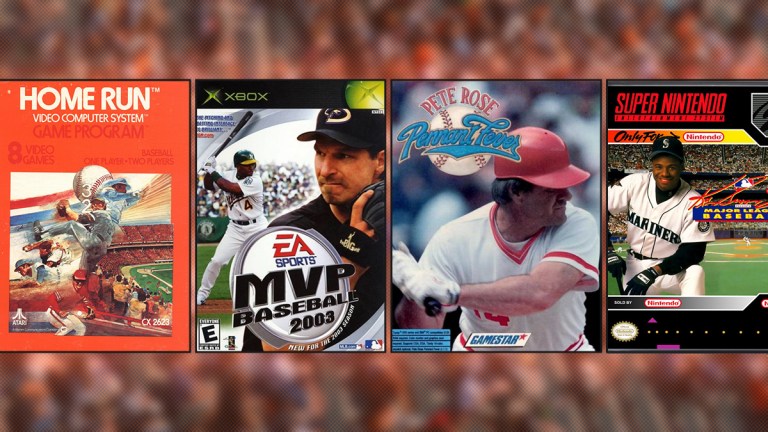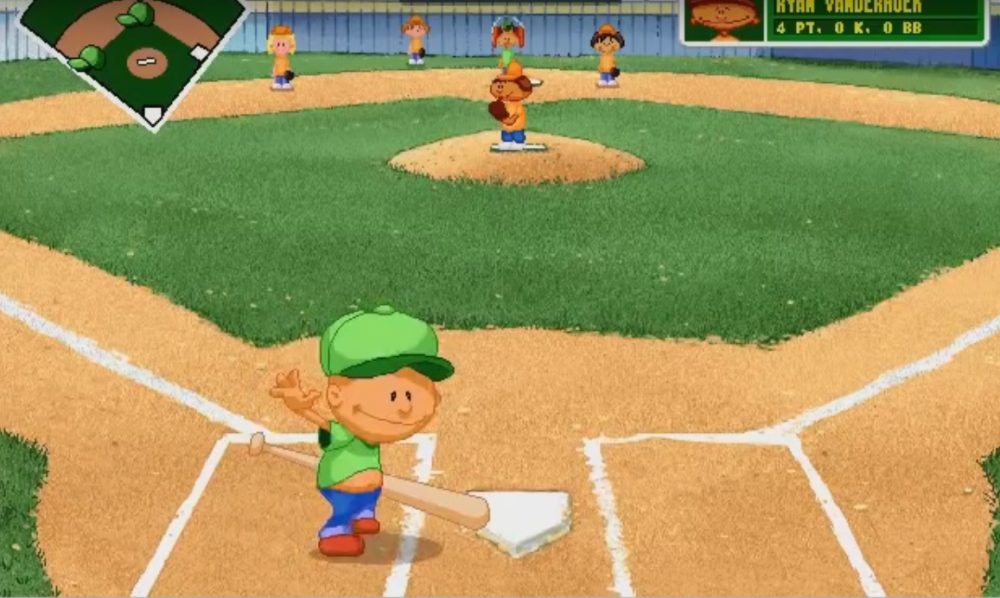Baseball Video Games: The Best Rookie Seasons in History
The inaugural games in baseball video game franchises often showed off major innovations.

In recent years, Major League Baseball has witnessed some of the best rookie campaigns in the game’s 150-plus year history. Each of the past three seasons featured the meteoric rise of a young superstar. In 2017 New York Yankees outfielder Aaron Judge entered his new chambers at Yankee Stadium and used his gavel to bash 52 home runs, a then rookie record. In 2018, Ronald Acuna unleashed his mix of power, speed, and swagger on the city of Atlanta and quickly became a Braves fan favorite, winning Rookie of the Year and setting himself up for a monster 2019 season that established him as a top-five player in the game. And in 2019 it was New York Mets first baseman Pete Alonso who became an immediate star on and off the field as he topped Judge’s 2017 home run record by hitting 53 homers in his first big league season.
Some young players get called up to “The Show” and flash signs of promise. More often rookies falter and need time to get acclimated to the game in order to realize their full potential. It’s no different with baseball video games. These are the outliers, though. Rookies come in all shapes and sizes. Some, in the case of former Tampa Bay Devil Rays pitcher Jim Morris, are 35-year old former high school science teachers who try out for the team on a bet (and subsequently get portrayed on the big screen by Dennis Quaid).
Dating back to the first baseball video game, Atari’s Home Run (1978), all the way to today’s standard-bearer, MLB The Show 20, the field has been crowded with competition. In 1998 alone there were nine baseball titles released for various platforms. That’s a tough market for a rookie video game franchise to penetrate.
Over the years, there have been plenty of standout inaugural editions of baseball video game franchises that showed all-star potential, introducing innovative new features that would really pop in subsequent installments. In the latest episode of our video series MLB The Show (The Show), we cut a full highlights package of the Best Baseball Video Game Rookie Seasons. You can watch the segment below or read on for a more in-depth look at the history of baseball video games.
Atari Dives Headfirst Into Home
Squint hard enough at the video below and you’ll see something that resembles a baseball diamond. That’s from the 1978 Atari 2600 game Home Run, the original baseball rookie given it was the first time the sport received the video game treatment on a platform.
Gamers were able to play against the computer or another player in a simplistic, paired down version of America’s Pastime. Batters had it easy: the game only had up to three fielders playing defense at a time and they all moved in unison because of the single joystick. A far cry from pitching meters and dynasty modes, Home Run will be remembered for getting us into the batter’s box. Call it ‘88 Walt Weiss—the Worst Rookie of the Year.
The first player to have his likeness tied to a video game was Hall of Famer and then Baltimore Orioles manager Earl Weaver with 1987’s Earl Weaver Baseball, a PC title from future sports video game powerhouse Electronic Arts. That game was notable for being the first to allow a full-season sim and a manager mode, and the first game to portray different stadiums on screen, including the first ever video game appearance of Fenway Park’s Green Monster and historical grounds like Ebbets Field and the Polo Grounds.
A decade after its first attempt at a baseball game, Atari really did some damage at the plate when it called on the Hit King for its 1988 title. The first installment Pete Rose Pennant Fever was innovative for a number of reasons; the game pioneered the behind-the-pitcher view, as well as offering alternate fielding views. It also used an advanced digitized sound system and was the first game to offer a career mode, a milestone building block that helped pave the way for today’s sims. Sadly, no book making mode was featured in the game. But if anyone was going to fearlessly barrel headfirst into the video game market, it was going to be Pete Rose leading the way. Like Weaver, Charlie Hustle was a manager at the time of the game’s release. We all know how that ended.
1988 was also the first year in which a current Major League player lent his likenesses to a video game: Reggie Jackson Baseball released on Sega, though to less fanfare.
As the decade came to a close, Atari put out an updated version of Pete Rose Pennant Fever for Atari 7800 in 1989, but that would be the end of the short-lived franchise as a new wave of rookies took over the industry in the ‘90s.
The Kids Want to Play As The Kid
As any baseball fan will tell you, the biggest story of the first half of the 1990s was the disconnect between Major League Baseball and the MLB Players Association, which culminated in the 1994 players strike and cancelation of the World Series for the first time in 90 years. We’re terribly sorry, Expos fans.
The labor strife extended to virtual ballfields. Until Sega Genesis released World Series Baseball in 1994, no baseball video game had been licensed by both the MLB/MLBPA, meaning games either used pro teams (including logos and stadiums) or used player likenesses, but never both in the same game. As the console wars began to heat up, so did the quest to land cover stars. In 1992, Cal Ripken, Roger Clemens, Nolan Ryan, and Tony La Russa all had rookie video game titles of their own. While Tony La Russa Baseball for Sega Genesis was the only game to secure the MLBPA license, none of these titles were trailblazers.
There was only one superstar able to cut through the baseball game clutter. Despite only having the MLB license, Super Nintendo’s 1994 title Ken Griffey Jr. Presents Major League Baseball was a massive commercial success. Player statistics accurately represented the 1993 season, so technically you could edit in the real names of players. Otherwise, Griffey was the only playable real-life star in the game. During the ‘90s, the biggest star in baseball shifted video game units like no other. The later titles in the franchise were more polished and beloved (give us the 3D graphics of Ken Griffey Jr’s Slugfest on N64 any day), but the 1994 installment changed the game for good.

Backyard Rules The PC
We’d be remiss to leave both PC gaming out and children’s games of the discussion. Let’s kill two birds with one stone here: Backyard Baseball (1997) can easily stake its claim as the best rookie game for both PC gaming and children’s titles. Humongous Entertainment authored a love letter to the diamond heroes of the schoolyard in a game that featured colorful, cartoon 2D graphics, with fictional players who had their own catch phrases and personality traits. The gameplay also had fun wrinkles like aluminum bat power-ups, zany specialty pitches, and unique ballfields like Tin Can Alley (an urban playing field), Dirt Yards (literally an empty dirt lot), or Steele Stadium (a baseball backyard of dreams).
To this day, the AOL generation that grew up on PC gaming has fond memories of Backyard Baseball: a Minor League Baseball franchise recently held a promotional night honoring the game and its best player, Pablo Sanchez. The success of the 1997 title led to an even more beloved sequel, Backyard Baseball 2001, which scored the coveted MLB/MLBPA license and added an interesting twist, allowing gamers to play as kid versions of MLB superstars like Randy Johnson, Mike Piazza, and Cal Ripken Jr. The original Backyard title spawned a franchise that extended to other sports and platforms through 2015.
The Console Pennant Race Heats Up
The rookie games of the latter half of the 1990s were foundational players that paved the way for today’s modern graphics, advanced game modes, and improved gameplay functionality.
Triple Play 1996, EA Sports’ forerunner to what would eventually be rebranded as the superior MVP Baseball franchise, deserves a tip of the cap, but little else. In 1997, MLB ‘98, featuring Bernie Williams on the cover, was the start of Sony’s yearly titles. The franchise would rebrand in 2006, correcting the silly practice of the games title being the next year, with MLB 06: The Show.
The real rookie MVP of this era was MVP Baseball 2003. It’s hard to overstate how much of a leap baseball video games took when the game debuted. At the time, Gamespot’s Brett Todd wrote in his review: “the new game gets more things right than the entire Triple Play series did in nearly a decade.” The introduction of the pitching meter, which was modeled after the swing functionality used in golf titles at the time, dictated the power and accuracy of a pitch. MVP 2003 also had huge graphics upgrades from EA’s Triple Play days. The game’s presentation—with a TV-style broadcast booth led by Duane Kuiper and Mike Krukow—and killer soundtrack helped put it over the top. Baseball fans saw the fruits of EA’s labor of love on MVP 2003 pay off when the final title in the franchise, MVP Baseball 2005, hit shelves. Many to this day consider it the best of the pre-next gen console era.
